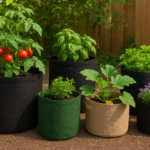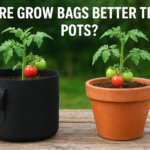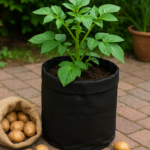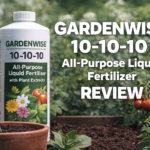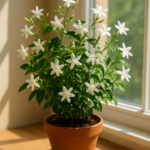What is the best potting soil for indoor plants? The best potting soil for indoor plants is a well-draining, nutrient-rich mix. Organic potting mixes with peat, pine bark, and perlite or vermiculite are top choices. A healthy and successful indoor plant depends on the right potting soil. A quality mix supports root development, retains moisture, and provides essential nutrients.
Gardeners often opt for organic potting soils that combine peat moss, pine bark, and either perlite or vermiculite. These ingredients ensure adequate aeration and moisture retention. The inclusion of compost or worm castings can enhance the nutrient content, promoting robust plant growth.
What Is Potting Soil?

Potting soil, also known as potting mix or potting compost, is a substrate used to grow plants in containers. The soil in potting soil is rarely or never mixed with soil. Instead, it is a blend of materials like sphagnum moss, bark, perlite, vermiculite, compost, or coir. Other materials used for growing mediums include peat, coconut coir, wood products like bark and wood fiber, perlite, stone wool, soils/tufts, and recycled paper and cardboard. Some mixes also include sand, vermiculite, and calcined clays.
Potting soil is designed to provide a healthy environment for potted plants to grow. It includes one or more materials that keep moisture, one or more materials that aid in aeration and drainage, and fertilizer. The ratio of these materials can be adjusted depending on the particular needs of the plant. Available potting soil is usually sterilized to avoid the spread of weeds and plant-borne diseases. This makes it safer for potted plants as it is free from fungus and other plant pathogens.
Benefits Of Using The Right Potting Soil For Indoor Plants
Healthy indoor plants start with a strong foundation, and that’s what the right potting soil delivers. Not only does it support plant growth, but proper soil also ensures optimal water retention and drainage, nutrient availability, and root aeration.
| Benefit | Description |
| Better Growth | The right mix nourishes plants, resulting in lush foliage and robust growth |
| Improved Drainage | Prevents water-logging, protecting roots from rot. |
| Adequate Nutrients | Supplies essential nutrients, promoting plant health. |
| Root Aeration | Allows roots to breathe and access oxygen easily. |
| Disease Prevention | Well-draining soil reduces the risk of disease and pests. |
Factors To Consider For The Best Potting Soil
The right potting soil is crucial to the health of indoor plants. Identifying what to look for can enhance the growth of plants. Here are the top factors to determine the best potting soil for indoor plants.
Nutrient Content
Plants need nutrients to thrive. Potting soil packed with essential nutrients is ideal. Look for a mix containing nitrogen, phosphorus, and potassium. These nutrients promote leaf growth, root development, and flower production.
- Nitrogen – Stimulates leaf growth
- Phosphorus – Helps root development
- Potassium – Encourages flower and fruit growth
Water Retention
Soil should hold moisture but not stay soggy. Materials like peat moss or coconut coir improve water retention. These help sustain plants between watering. Avoid over-drying or waterlogging.
| Material | Benefits |
| Peat Moss | Retains water effectively |
| Coconut Coir | Eco-friendly and retains moisture |
Drainage
The best potting soil must also ensure excess water drains well. Good drainage prevents root rot. Look for soil with perlite or sand. These components allow water to flow.
- Perlite: Enhances aeration and drainage
- Sand: Prevents soil compaction, aiding drainage
Different Types Of Potting Soil
Indoor plants thrive in the right soil, and choosing the right type can make a big difference. From moisture retention to aeration, different soils offer various benefits. Learning about the potting soil options can help plant lovers select the ideal mix. Here are some common types:
Peat- Based Potting Soil With Perlite
Peat-based potting soil with perlite is a type of potting soil that contains peat moss as its primary ingredient and perlite as an additive. Perlite is a occurring siliceous rock that is heated to expand its volume. Perlite is useful for improving aeration, drainage, and insulation in potting mixes, and it can speed up germination and rooting.
Peat-based potting soil with perlite is useful for plants that need acidic soil, such as blueberries. Besides, peat moss is harvested from peat bogs, one of the planet’s largest carbon sinks, and harvesting peat can impact the environment.
There are many alternatives to peat-based potting soil, such as coconut coir, compost, and bark-based mixes, which can be more sustainable options for gardening.
Key Features
- Absorbs water efficiently
- Provides good aeration
- Stabilizes plant roots
Coco Coir-Based Potting Soil
Coco coir-based potting soil is potting soil that contains coconut coir as its main component. A byproduct of processing coconuts, coco coir is a sustainable substitute for peat moss. Potting soil based on coco coir is great for drainage and water retention, which makes it perfect for indoor as well as outdoor plants.
Mixing compost with perlite or vermiculite can improve its quality. The weed-free, odorless, and sterile properties of coco coir make it an ideal potting soil. Diverse growing media can be used for seed beginning, hydroponics, and soil improvement. When it comes to gardening, using potting soil based on coco coir as opposed to peat is sometimes a more environmentally friendly choice.
Key Features
- Enhances water retention
- Resists compaction
- Promotes healthy root growth
Vermiculite And Perlite Mix For Plants
Vermiculite and perlite can be mixed in a potting mix for plants. Perlite acts as an aerator, helping the soil shed water, while vermiculite acts as a sponge to help the soil hold moisture. The ratio of vermiculite to perlite can be adjusted depending on the particular needs of the plant. For example, vermiculite can be used for plants that need a moist environment, while perlite can be used for plants that need to dry out before watering again. Plants that love moisture, such as African violets, often require potting soils with vermiculite and perlite. Peat moss, coco coir, compost, and sand can also be added to potting mixes.
Key Features
- Moisture Retention: Vermiculite has excellent water-holding properties
- Nutrient Retention: Vermiculite helps in retaining essential nutrients
- Root Growth: The growth of roots is accelerated by perlite
Top Recommendations For Indoor Plants
Top Recommendations for Indoor Plants involve choosing the right potting soil, essential for plant health and growth. Each plant type has preferences for soil composition and drainage, so let’s dive into the best options available.
Espoma Organic Seed Starter Premium Potting Mix
Espoma Organic Seed Starter Premium Potting Mix is an organic potting mix designed for growing seedlings and cuttings. It contains a blend of sphagnum peat moss and perlite, which provides excellent moisture retention and aeration for healthy root growth. The mix is also enhanced with yucca extract and lime to ensure the correct pH level.
Myco-tone, a proprietary blend of mycorrhizae, helps new plants grow larger roots and grow faster. The potting mix is 100% natural and organic approved, making it safe for people, pets, and the planet. It is suitable for starting seeds and rooting cuttings indoors in late winter or early spring for transplanting into the garden. The mix is available in an 8-quart bag and can be used in peat pots or special seed starting trays with drainage holes. Some users have reported issues with fungus gnats in the mix, but it is a highly-rated product that many gardeners trust.
About this item
- CONTAINS: To achieve the proper pH, the sustainable Seeds Stating soil mix is a rich blend of sphagnum peat moss, perlite, and yucca extract, along with lime.
- MYCO-TONE: Combining endo and ecto mycorrhizae to create.
- WHEN TO USE: Apply to initiate seed germination. Excellent for a variety of plant varieties, including flowers, vegetables, herbs, and more. Suitable for rooting leaf and stem cuttings as well.
- PROMOTE ROOT GROWTH: The use of a natural seed starter mix ensures maximum moisture retention and oxygen availability.
- ORGANIC GARDENING: Involves a sophisticated fusion of the highest quality natural components.
Mosser Lee ML1113 Desert Sand 7 lb.
Mosser Lee’s Decorative Sands are renowned for their beauty and exceptional quality, earning high praise from both users and professional interior decorators. These clean sands, crafted to enhance soil drainage for potted plants, are now utilized in horticultural, school, and craft projects. Recognized for their versatility, Mosser Lee’s Decorative Sands stands out as the top choice for those seeking premium and pleasing options on the market.
About this item
- New larger size
- Improves the look of house plants by covering the soil
- Suitable for decorative use in clear vases, dish gardens, and terrariums
- Loosen heavy or compacted soil
- Helps protect and keep moisture
Soil Moist Vacation Watering Mats for Indoor
Soil Moist Vacation Mats – a convenient solution for watering potted plants in your absence. These mats, containing water-storing polymer crystals woven into a cloth material, can last up to three weeks between waterings. Simply place the potted plants on the mats for neat and easy use. Each 15-3/4 by 11-inch mat holds up to two quarts of water, gradually releasing it to the plant root area. Each package includes 2 mats, providing a hassle-free method to keep your plants hydrated while you are away.
About this item
- Water plants while you are away for up to 3 weeks
- Each mat absorbs up to 2-quart of water and releases it to the plant root area
- Brand: Soil Moist
- Item Weight: 0.25 lbs
FAQs
What Kind Of Soil Is Best For Indoor Plants?
Indoor plants thrive in well-draining, nutrient-rich soil. A mix containing peat moss, perlite, and vermiculite offers good aeration and moisture retention. For succulents and cacti, a sandy potting mix suits their preference for dry soil.
What Is The Best Potting Mix For Indoor Plants?
The ideal mix should combine organic matter like peat or coconut coir with inorganic materials like perlite. A balance of these elements ensures your plants have proper drainage, nutrition, and root support.
What Soil For Potting On House Plants?
Select a potting mix designed for indoor use. Avoid garden soil as it can be too dense and may contain pests. Look for labels indicating the mix is suitable for the type of house plant you are potting.
Is Potting Soil Or Potting Mix Better For Indoor Plants?
It is better to use a potting mix for indoor plants as it provides better aeration and moisture control than standard potting soil, resulting in healthier plants.
What Is The Best Potting Soil For All Plants?
The best potting soil for all plants is a well-draining, nutrient-rich mix containing peat, pine bark, and perlite or vermiculite.
Is Miracle-Gro A Good Potting Soil?
Miracle-Gro provides a nutrient-rich potting mix that supports healthy plant growth. Many gardeners find it effective for container gardening.
Conclusion
Selecting the right potting soil is crucial for thriving indoor plants. What is the best potting soil for indoor plants? It’s a balance of moisture, nutrients, and aeration. Tailor your choice to your plant’s needs, and you’ll see robust growth. Remember, the best soil fosters root health and supports your greenery’s vitality. Happy planting!



